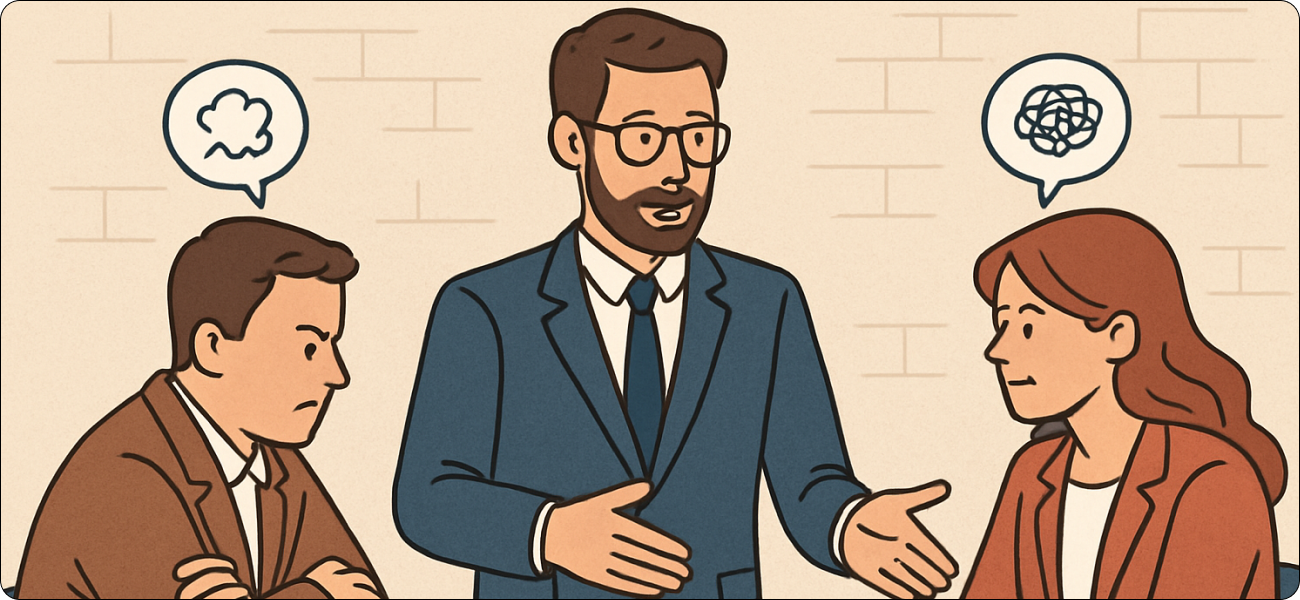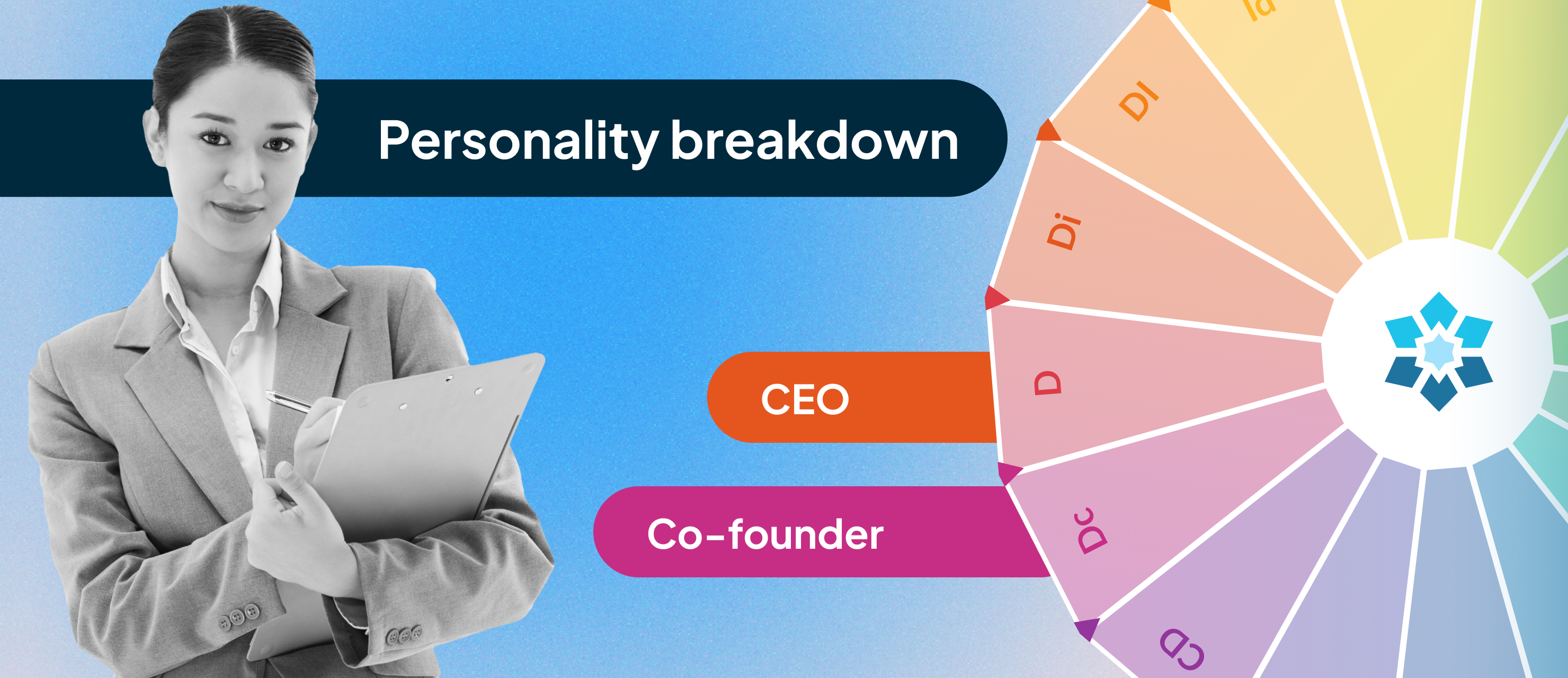.png)
coaching-and-leadership
Anyone can be a boss. It takes adaptability, vision, and empathy to be a true leader.
A boss is a title you're given; a leader is a role you earn.
True leadership requires flexibility because every team is a dynamic mix – from the person laser-focused on the finish line, to the one brimming with a thousand ideas before lunch.
The real challenge is knowing which moves to make: when to clear the runway and get out of someone's way, when to act as a human shield against last-minute "great ideas" from upstairs, or when to be the one who slams the brakes to demand better data.
This guide is your playbook for mastering that shift. We'll show you better understand your team and make the right call across five key management areas.
Decoding Your Team: A Quick Guide to the 4 Working Styles
Think of the DISC framework as a playbook for your team. It's a science-backed way to understand workplace behavior, helping you stop guessing and start leading by recognizing four predictable patterns:
|
D (Dominance) → Results + speed. Wants ownership & fast decisions. I (Influence) → Ideas + energy. Wants collaboration & visibility. S (Steadiness) → Stability + support. Wants predictability & partnership. C (Conscientiousness) → Accuracy + logic. Values standards & data. |
While some people fit neatly into one of these four boxes, many are a blend of two neighboring styles. Your job isn't to get bogged down in the exact mix – it's to spot the dominant pattern and adapt to it.
In this guide:
|
Cheat Sheet: Adaptive Leadership |
💡 Want a shortcut to applying this guide? Invite your team to take the free Crystal Knows DISC assessment. You'll get a personalized playbook for leading each person more effectively.
1. Setting the Direction:
Delegation, Deadlines, and Leadership Styles
The Goal: To launch projects with clarity and deliver them on time by adapting how you delegate tasks and manage pressure.

💡 Pro-Tip: The key to project success is focus. Create it at the start by defining one owner and a clear outcome, and protect it near the deadline by locking the scope.
For D-Styles:
- When Delegating: They see a clear goal as a target to be obliterated. Give them the goal and constraints, then get out of their way. “The goal is X by Friday with Y budget. Let's touch base Wednesday.”
- When a Deadline Looms: Their stress comes from obstacles, not hard work. Lock the scope, clear their path, and let them execute.
For I-Types:
- When Delegating: They'll come back with ten ideas, nine of which are impossible but one of which is pure gold. Give them space to brainstorm before committing. “Bring three creative options on Thursday; we'll pick one and lock in the next steps.”
- When a Deadline Looms: Their energy can spike but also scatter. Focus them on one visible, high-impact win to keep them engaged.
For S-Types:
- When Delegating: A clear plan is like a warm blanket for them; a vague goal is a bucket of cold water. Clarify roles and set steady milestones. “You'll own the research phase; the first milestone is next Tuesday.”
- When a Deadline Looms: Their anxiety rises with late changes and surprises. Reconfirm the plan and act as a buffer to protect them from distractions.
For C-Types:
- When Delegating: They'll read a one-pager three times and find the one critical flaw you missed, saving the entire project. Provide a written brief with all the details. “The one-pager has the details. Let's review it Thursday before you begin.”
- When a Deadline Looms: Their frustration comes from shifting criteria. Freeze the requirements and use data to triage any new requests.
2. Communicating Effectively:
Leadership Styles for 1-on-1s and Team Meetings
The Goal: To run conversations that respect everyone's time, build trust, and end with clear, owned decisions.
8f86.png?width=800&height=359&name=Frame%2015770%20(2).png)
💡 Pro-Tip: Whether in a 1-on-1 or a team meeting, always use a shared agenda to drive the conversation. Start by defining the desired decision and end by assigning a single owner to the action items.
For D-Types:
They see any meeting as a means to an end and value efficiency above all.
- In Team Meetings: State the goal and the decision-owner at the start to keep everyone on track.
- In 1-on-1s: Keep it short and focused on decisions and blockers. For them, a 15-minute meeting that ends in 10 is a huge win.
For I-Types:
They need airtime to brainstorm and feel connected to the team's energy.
- In Team Meetings: They'll keep the discussion going with "just one more idea!" if you don't provide structure. Allow for energetic collaboration before pushing to converge.
- In 1-on-1s: Start by celebrating a recent win to tap into their need for recognition, then guide the conversation to concrete next steps.
For S-Types:
They are most comfortable and productive when they know what to expect.
- In Team Meetings: A surprise agenda item makes them visibly uncomfortable. Share a predictable agenda early so they can contribute thoughtfully.
- In 1-on-1s: Reassure them by checking in on their well-being before diving into tasks. A simple, "How are things going?" goes a long way in building trust.
For C-Types:
They respect a manager who has done their homework and values data.
- In Team Meetings: If you send a pre-read 10 minutes before, you've already lost them. Give them 24 hours, and they'll be your most valuable contributor.
- In 1-on-1s: Come prepared to discuss the details of their work. Reviewing their analysis beforehand shows respect and leads to a much more productive conversation.
3. Developing Your People:
Giving Feedback and Recognition Based on Working Styles
The Goal: To deliver feedback that lands and offer recognition that motivates, strengthening your team members' skills and commitment.

💡 Pro-Tip: To develop your people, be specific and intentional. Use the Situation-Behavior-Impact (SBI) model for feedback to connect behavior to impact, and tailor your recognition to what truly motivates each individual working style.
For D-Types:
Their currency is results. Praise their wins, give constructive feedback on misses that could've been bigger wins, and offer recognition with more ownership. “Your speed on that project was a win. As recognition, you’re leading the next one.”
For I-Types:
Their currency is influence. Praise them publicly, give constructive feedback privately (always after noting their good intent), and offer recognition with visibility. “Your energy sold that room. To recognize that, you’re co-leading the next big share-out.”
For S-Types:
Their currency is stability. Praise their reliability in private, give constructive feedback privately to ensure stability, and offer recognition by highlighting their importance to the team. “Your consistency is the rock this team is built on. We couldn’t do this without you.”
For C-Types:
Their currency is expertise. Praise them with data that proves their quality, give constructive feedback with objective evidence, and offer recognition by celebrating their mastery. “Your analysis was flawless—the data proves it. As recognition, we’re making your process the new team standard.”
4. Leading Through Change:
How to Communicate Rollouts and New Initiatives
The Goal: To communicate change in a way that builds buy-in and reduces friction by answering the questions each style will have.
e271.png?width=800&height=369&name=Frame%2015771%20(1).png)
💡 Pro-Tip: People adopt change for different reasons. Tailor your message to explain the why, what, and when for each working style.
For D-Types:
Explain the Impact: They see change as a potential obstacle to their goals. Skip the long-winded preamble and get straight to the point: what’s changing, why, and how does it help them win? Give them the new playbook, not the philosophy.
For I-Types:
Explain the People: They experience change through the lens of people and energy. They’ll be the first to either champion the new direction or spread rumors of doom, depending on how well you tell the story. Get them excited and give them a visible role in the rollout.
For S-Types:
Explain the Stability: Change feels like a threat to their stability. While everyone else focuses on the new thing, they are laser-focused on the potential for chaos. Your first job is to be a calming force and anchor them by explaining what isn't changing.
For C-Types:
Explain the Data: They are the built-in quality control for your plan. They will stress-test every assumption, not to be difficult, but to prevent failure. Earn their buy-in by presenting the data, the alternatives you considered, and the rationale for your decision before they even ask.
5. Resolving Team Conflicts:
Using Your Management Style to Mediate and Build Trust
The Goal: To resolve disagreements decisively while maintaining team trust and focusing on the path forward.

💡 Pro-Tip: To resolve conflict, name the tension (e.g., "speed vs. quality"), frame two clear paths forward, and choose one path to commit to.
For D-Types:
Choose a Path: To them, ongoing conflict is just inefficiency. They get frustrated by endless debate and respect a leader who can absorb the arguments and make a clear, decisive call. For them, indecision is worse than a wrong decision.
For I-Types:
Get Buy-In: They are highly attuned to the team’s harmony and feel the "bad vibes" of a conflict personally. They won’t buy into a decision until they feel the emotional impact has been considered. Acknowledge the tension before presenting the solution.
For S-Types:
Align Relationships: Conflict is a major source of stress for them, and they’ll often go silent to avoid rocking the boat. You need to create a safe space for their concerns and explicitly reassure them that the team relationship will remain stable after the decision.
For C-Types:
Log the Rationale: They detach emotionally and want to resolve conflict with logic and facts. To get their buy-in on a subjective call, you must document the 'why' and the criteria used, so the decision feels objective and final.
The Adaptive Leadership Cheat Sheet: A DISC Guide
Here’s a quick-reference guide. Scan the row for the management moment, then find the column that matches your team member’s working style.
| Moment | D - Types | I - Types | S - Types | C - Types |
|---|---|---|---|---|
| Direction | Be Directive: Set clear goals | Co-ideate: Explore options |
Guard: Protect their focus | Define: Set firm criteria |
| Meetings | Drive Decisions | Facilitate Brainstorming | Invite Quiet Voices | Provide Pre-Reads |
| Development | Link to Impact | Recognize Publicly | Praise Privately | Celebrate Mastery |
| Change | State the "What" | Explain the "Who" | Confirm "What Stays" | Present the "Why" |
| Conflict | Choose the Path | Get Team Buy-In | Align Relationships | Log the Rationale |
The Benefits of Developing Adaptive Leadership Skills
Mastering adaptive leadership isn't just a nice-to-have skill; it's the difference between a team that clicks and a team that clashes. When you stop managing everyone the same way:
-
You actually move faster. You stop having to re-explain the same task three different ways because you get it right the first time.
-
Your team trusts you. People feel seen and understood, not managed like a line item on a spreadsheet.
-
You end the "speed vs. quality" war. You'll know when to hit the gas for your D-types and when to slam the brakes for your C-types.
You don’t have to become a different person to be a great leader. You just need more plays in your playbook. Think of this guide as your strategy and tools like Crystal Knows as the real-time intel that helps you call the right play, for the right person, at the right time.
[ Create your FREE Crystal Knows account today ]
Recommended posts
Why Crystal?
Personality
Content








